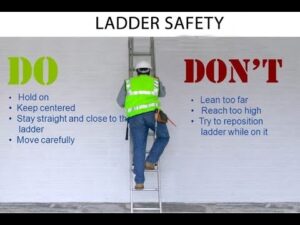August Safety Tip
Minimizing Injuries Through Ladder Safety
Falls from elevated surfaces are frequently listed as one of the top 10 causes of accidents in the workplace. Most of these accidents occur due to failure to follow basic ladder safety. In an industry that commonly utilizes ladders, prevent injuries by practicing the following safety tips.
Setting up Safely
Make sure your employees select the correct ladder for the job by checking the length and duty rating. Proper length is a minimum of 3 feet extending over the working surface.
Instruct your employees to inspect their ladder before each use for loose or damaged parts. Other items to inspect the following:
- Steps
- Rungs
- Spreaders
- Rung dogs
- Safety feet
- Other parts
Employees should clear the area where they will be working. Never place a ladder in front of a door that isn’t locked, blocked or guarded.
Because metal ladders conduct electricity, use a wooden or fiberglass ladder near electrical equipment or machinery.
Train employees to check that all locks on extension ladders are properly engaged before placing a ladder on a steady surface. The ground underneath the ladder should be level and firm. Large, flat wooden boards braced underneath a ladder can help level it on an uneven surface or soft ground. Never place a ladder on top of extra stock, product boxes or other potentially unstable surfaces. Straight, single or extension ladders should be set up at approximately a 75-degree angle.
Use the 1:4 ratio to ensure safety when on a ladder. Place the base of the ladder one foot away from whatever it’s leaning against for every four feet of height to the top of the ladder.
Use Caution
Always use caution when using a ladder and do not use a ladder for any other purpose than intended. Other safety considerations include the following:
- Make sure the weight that a ladder is supporting does not exceed its maximum load rating (user plus materials). Only one person should be on a ladder at a time.
- Keep body centered between the rails of the ladder at all times. Do not lean too far to the side while working. Never overreach—instead, descend from the ladder and move it to a better position.
- Do not step on the top step or bucket shelf, and do not attempt to climb or stand on the rear section of a stepladder.
- Always face the ladder when climbing up or down. Never leave a raised ladder unattended.
- Employees should slowly step down from a ladder if they feel dizzy or tired.
- Non-slip footwear should be worn at all times when on a ladder. Keep non-slip footwear available to since dress shoes can pose a safety threat on a ladder.

